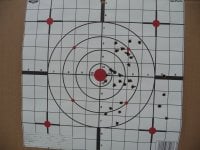- Thread starter
- #21
longrangehunter
Handloader
- Jun 19, 2011
- 1,756
- 567
Oh I'll get the P35 out! I never like going into something blind like I did yesterday, and why measuring case head expansion doesn't work IMO! Those were all within every 223 case I've ever measured and yet the last one @ 20.6 was way too hot! Punched the plunger well into the case head and had some powder burn 1/3 the way around the primer! No-No-No!
I wouldn't have worried had the data come from a manual, but that powder was too fast and not used by anyone in that bullet weight. I should have known better but the QL program lured me into a false sense of security, and no, I'm not blaming it or you for it. Which is why a chronograph is so important, although even then knowing the amount of gain/loss due to barrel length still needs to be addressed, as well as the small variances in powders lot to lot.
I'll think of that one round as a proof round test, I'm sure DD builds them to endure a round cooking in the chamber at over 250* degrees and then being fired after a long battle. But I'm not about to keep testing without the chronograph getting into unknown territory again.
Thanks Dewey.
I wouldn't have worried had the data come from a manual, but that powder was too fast and not used by anyone in that bullet weight. I should have known better but the QL program lured me into a false sense of security, and no, I'm not blaming it or you for it. Which is why a chronograph is so important, although even then knowing the amount of gain/loss due to barrel length still needs to be addressed, as well as the small variances in powders lot to lot.
I'll think of that one round as a proof round test, I'm sure DD builds them to endure a round cooking in the chamber at over 250* degrees and then being fired after a long battle. But I'm not about to keep testing without the chronograph getting into unknown territory again.
Thanks Dewey.






